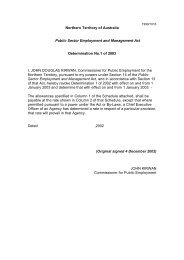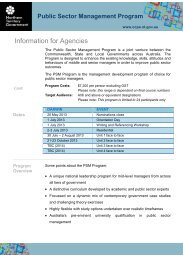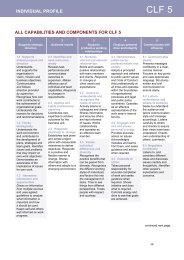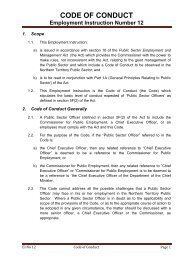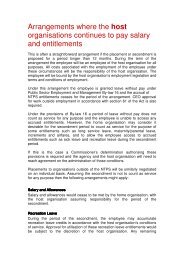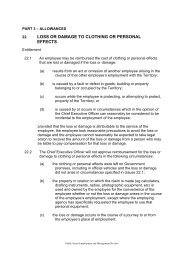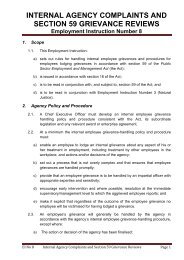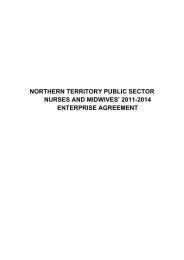Making Workforce Planning Work in the NT Public Sector
Making Workforce Planning Work in the NT Public Sector
Making Workforce Planning Work in the NT Public Sector
You also want an ePaper? Increase the reach of your titles
YUMPU automatically turns print PDFs into web optimized ePapers that Google loves.
Mapp<strong>in</strong>gAdvanced workforce plann<strong>in</strong>g should <strong>in</strong>clude mapp<strong>in</strong>gof workforce requirements. The mapp<strong>in</strong>g should be<strong>in</strong>teractive and provide key data about <strong>the</strong> <strong>in</strong>dustry,<strong>the</strong> job group(s) required, <strong>the</strong> timeframe for requiredworkforce and <strong>the</strong> key contact details.Report<strong>in</strong>g<strong><strong>Work</strong>force</strong> plann<strong>in</strong>g report<strong>in</strong>g should be concise and bebased on evidence. Reports should focus on <strong>the</strong> ‘data story’ of <strong>the</strong> current, <strong>the</strong><strong>in</strong>com<strong>in</strong>g and <strong>the</strong> exit<strong>in</strong>g workforce and demonstrate <strong>the</strong> alignment of agencybus<strong>in</strong>ess needs with those of its employees. Once <strong>in</strong>tegrated <strong>in</strong>to normalbus<strong>in</strong>ess practice and <strong>in</strong>corporat<strong>in</strong>g technology for supply gap calculations,workforce plann<strong>in</strong>g report should be available 24/7 for executive assessment.Evaluat<strong>in</strong>g and monitor<strong>in</strong>g<strong><strong>Work</strong>force</strong> plann<strong>in</strong>g and development outcomes should be monitored andevaluated at regular <strong>in</strong>tervals to enable process ref<strong>in</strong>ement and evolution andmonitor<strong>in</strong>g of workforce plann<strong>in</strong>g capabilities with<strong>in</strong> <strong>the</strong> agency.Australian and New Zealand Standard Classification ofOccupations (ANZSCO) codesIf you are delegated responsibility for workforce plann<strong>in</strong>g (strategic oroperational), it is important to have an understand<strong>in</strong>g of <strong>the</strong> ANZSCO systemand codes. These can be complex but it is best to keep your referenc<strong>in</strong>gsimple.The ABS offer clear def<strong>in</strong>itions and explanations for <strong>the</strong> codes which cover <strong>the</strong>follow<strong>in</strong>g:• <strong>the</strong> ‘job’ – a set of tasks designed to be performed by one <strong>in</strong>dividual <strong>in</strong>return for wage or salary• <strong>the</strong> ‘occupation’ – a set of jobs with similar sets of tasksTip:• Remember, no matterhow well you plan, yourworkforce always has anopen door to exit youragency. The aim is toengage <strong>the</strong>m <strong>in</strong> workforceplann<strong>in</strong>g and workforcedevelopment so that <strong>the</strong>ychoose to stay.• <strong>the</strong> ‘skill level’ – <strong>the</strong> range and complexity of <strong>the</strong> set of skills required for<strong>the</strong> job.Some agencies may have established <strong>the</strong>ir own job group/job family codes toplan <strong>the</strong>ir workforce. While this is useful, <strong>in</strong> <strong>the</strong> current and projected economicclimate it is suggested that agencies consider align<strong>in</strong>g <strong>the</strong>ir job groups toANZSCO codes.38



